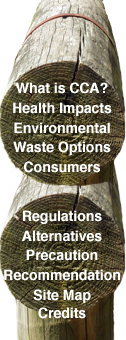Alternatives
Physical Alternatives
Much of the discussion around CCA looks toward less toxic, chemical treatments. However, there is a broad spectrum of non-chemical wood treatments as well as substitute materials that do not require treatment with toxic metals.
Untreated hardwoods that are naturally pest-resistant, such as cedar, redwood, beech, and some species of Eucalyptus, can provide a timber alternative (Feldman, 2002; Robinson et al, 2004). Alternatively, wood susceptible to termites and fungal rot can be heat- or radiation-treated. This treatment, which has been commercialized by some European companies, alters the ‘structure and/or composition of the wood, rendering it less susceptible to biological attack or alternatively destroys wood degrading organisms in situ’. An additional benefit to this treatment is that the waste wood can be easily reused as fuel wood (Enviros Consulting et al, 2004, p135).
Timber can be substituted by other materials, depending on the required performance. These include steel, concrete, plastic marine pilings, composite lumber made with recycled plastic, some of which can be recycled material to reduce the environmental impacts of its manufacture and disposal (Feldman, 2002; Robinson et al, 2004; Repeat Products, 2005). Alternative materials for vineyard stakes might include untreated hardwood, creosote-treated pine and hardwood, precast concrete, old rail line, steel, plastic, and plantation thinnings (Smith and Mollah, 2004). Physical barriers such as metal mesh, specially graded granite chips, or an exposed concrete floor slab, can be installed to prevent termite damage in homes, supplemented by active early detection facilitated by raised floors and ant caps (WA DOCEP, 2004).
The CSIRO continues to promote the use of CCA-treated timber because alternatives include ‘more environmentally harmful materials such as aluminium, steel and concrete. These are not renewable, and greenhouse gases are generated in large quantities during their manufacture’ (CSIRO, 2002). When interviewed, it appears they have evaluated ‘environmental harm’ based on embodied energy and its greenhouse implications (Cookson, L., CSIRO Forestry and Forest Products, Pers. Comm., 14/12/04) whilst neglecting CCA-treated timber’s potential to create soil and water contamination, health problems, toxic waste, and an ongoing legacy of spent timber and ash.
The problem is that there is little incentive to research and develop cost effective alternatives whilst CCA is readily available for use. Chemistry and Industry, the magazine of the Society of Chemical Industry in the UK, reported that in Europe, the ‘increasing scrutiny’ that CCA treatments was coming under in the 1990s was ‘one of the major driving forces in the development of new wood preservation systems.’ (Suttie, 1997).
In Australia, the Forest and Wood Products Research and Development Corporation, a government statutory body, has not sponsored much non-biocidal R&D, reasoning that industry prefers a ‘treatment that has been tested in a range of climatic and geographical applications’. It claims there is ‘reluctance by design engineers to use/specify any materials that have not been treated to a stated degree of uniformity, and a concern that the physical treatments would alter the mechanical properties (eg durability and performance) of the wood’ (Lafferty, C., Forest and Wood Products Research and Development Corporation, Pers. Comm., 29/11/04). The focus of Australian funding on biocidal R&D for wood preservation will obviously limit the development of non-chemical alternatives in Australia.
References:
CSIRO (2002), ‘CCA Facts’, Commonwealth Scientific and Industrial Research Organisation website, http://www.ffp.csiro.au/wft/wpc/ccafact1.html (accessed 11/11/04).
Enviros Consulting and The BioComposites Centre, University of Wales (2004), Treated Wood Waste: Assessment of the Waste Management Challenge, The Waste & Resources Action Programme (WRAP), UK.
Feldman, Jay (2002), ‘Letter to US EPA: Beyond Pesticides Comments on CCA-Treated Wood’, Beyond Pesticides website, March 22, http://www.beyondpesticides.org/wood/alerts/CCA_comments.htm
Repeat Products (2005),Website, http://www.repeatproducts.com.au/
Robinson, B. Greven, M., Sivakumaran, S., Green, S. and Clothier, B. (2004), Results of an initial survey of the leaching from treated posts in vineyards in the Marlborough region, Horticulture and Food Research Institute of NZ Ltd for the Marlborough District Council, New Zealand, May.
Smith, T. And Mollah, M. (2004), ‘CCA Review Implications For Viticulture’, The Australian & New Zealand Grapegrower And Winemaker, Ryan Publications, April.
Suttie, E. D. (1997), ‘Novel Wood Preservatives.' Chemistry and Industry 15 September, pp. 720-4.
WA DOCEP (2004), ‘Termites and Your Home’, Department of Consumer and Employment Protection website, Western Australia, August, http://www.docep.wa.gov.au (accessed 8/11/04).


